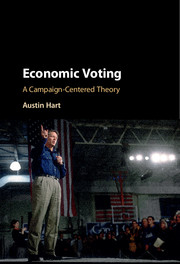Book contents
- Frontmatter
- Dedication
- Contents
- List of Figures
- List of Tables
- Acknowledgments
- 1 The Economic Voting Puzzle
- 2 A Campaign-Centered Theory of Economic Voting
- 3 Can Ads Prime the Economy? How Would We Know? US 1992
- 4 The Impact of a Surge in Economic Messages: Mexico 2006
- 5 The Absent Economic Message: US and Mexico 2000
- 6 The Campaign-Centered Model in Comparative Perspective
- 7 Conclusion
- Appendix
- References
- Index
Appendix
Published online by Cambridge University Press: 05 September 2016
- Frontmatter
- Dedication
- Contents
- List of Figures
- List of Tables
- Acknowledgments
- 1 The Economic Voting Puzzle
- 2 A Campaign-Centered Theory of Economic Voting
- 3 Can Ads Prime the Economy? How Would We Know? US 1992
- 4 The Impact of a Surge in Economic Messages: Mexico 2006
- 5 The Absent Economic Message: US and Mexico 2000
- 6 The Campaign-Centered Model in Comparative Perspective
- 7 Conclusion
- Appendix
- References
- Index
Summary
Here I present and describe estimates of the statistical models I used to generate the tables and figures throughout the book. I also provide detailed information about variable coding and construction, and the method I used to content-code televised ads and newspaper stories. Finally, I show estimates of several tests of robustness.
PROCEDURE FOR CONTENT-CODING ADS AND NEWSPAPER STORIES
In order to measure campaign content, I conducted an original content analysis of all candidate-sponsored presidential campaign advertisements in the 1992 and 2000 US presidential elections and the 2000 and 2006 Mexican presidential elections. In each case, I limit my analysis to those ads sponsored by the major candidates. I exclude co-sponsored ads and ads sponsored by interest groups or the political party as a whole (not the candidate). I also exclude “unsponsored” ads. I only coded ads from the general election campaigns.
I accessed video of the campaign spots for the 2006 Mexican presidential election from the Mexican Federal Electoral Institute's (IFE) website. For Mexico 2000, Vidal Romero, Professor of Political Science at the Instituto Tecnológico Autónomo de México (ITAM), generously provided video of the ads. For US 1992, I purchased video of the primary and general campaign ads from political scientist Darrel West. I purchased story boards and scripts of the ads aired in the 2000 US presidential election from the Wisconsin Ad Project.
I coded each ad for any spoken mention of the economy. I considered mentions of things like unemployment, jobs, growth, debt, inflation, prices, the economy, prosperity, trade, taxes, and business conditions to be mentions of the economy. No visual elements – including words displayed on the screen – were coded. I did code songs and jingles, even if they played in the background. I then weighted eaot by the centrality of the economic message. The weighting scheme is as follows: 1 = The economy is of primary importance; 0.75 = The economy is of secondary or tertiary importance; 0.5 = The economy is of only minor importance; 0.25 = The economy is mentioned only in passing; 0 = No economic mention. I used the Gestalt method, taking my immediate, overall impression of the focus on economic themes, rather than counting individual mentions of the economy.
Information
- Type
- Chapter
- Information
- Economic VotingA Campaign-Centered Theory, pp. 163 - 194Publisher: Cambridge University PressPrint publication year: 2016
